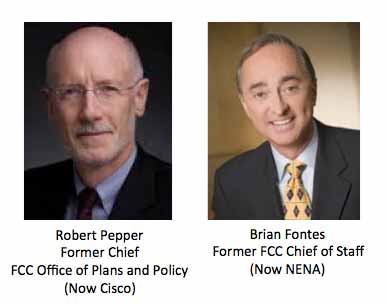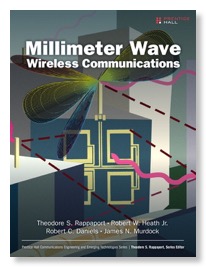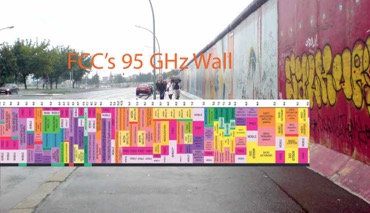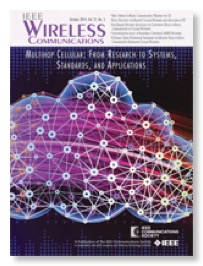2 Unsung FCC Pioneers in Early 5G #HighBandSpectrum Policy

(UPDATE: Robert Pepper is now with Facebook)
There is an implicit viewpoint at FCC that telecom technology is like a "conveyor belt sushi"/kaitensushi /回転寿司 restaurant in Japan: you sit at the counter and various types of sushi come on a conveyor belt in front of you unordered and you just wait until you see one you like and then take it off for eating. So at FCC you just wait for telecom technology to magically come from a conveyor belt and you pick winners and ignore the losers.
Video on "conveyor belt sushi"/kaitensushi /回転寿司 in Japan from NHK
Well, telecom technology does not come by magic! It requires bright people with good ideas and then investment in R&D to work on such ideas. In radio technology, the risk of that investment and thus its commercial likelihood depends on regulatory risk of FCC approving the commercial use and hence profitability of the technology.

"it took about ten years for low-cost commercial products to evolve from 1998 (sic) when USA became the first country in the world to authorize low-power 60 GHz operation…(S)hort range wireless networks provided the relevant applications to take advantage of unlicensed 60 GHz spectrum, as well as other frequencies in the mmWave band…Due to the inherent nature of mmWave frequencies … many emerging or future mmWave wireless products and standards (such as 5G mmWave cellular, inter vehicular communications, and backhaul/fronthaul communications standards) are likely to share characteristics with the 60 GHz WPAN/WLAN standards.
Thus #HighBandSpectrum 5G did not come unsummoned from a sushi conveyor belt, but derived from earlier visionary FCC action in Docket 94-124 in the Hundt Chairmanship. In my main website I have given more background of how this came about, here let me emphasize the role of the 2 individuals shown above.
When I proposed the concept of a 60 GHz unlicensed band in late1992 to the leadership of FCC's Office of Engineering and Technology, it was immediately rejected. This was probably because of the FCC culture related to "Nobody every got fired for buying IBM", i.e. if you only do things major regulatees propose you can never be criticized. (At the time I was working in EB's predecessor FOB as part of an "internal exile" resulting from the Docket 81-413 proceeding that is now known as the basis of Wi-Fi and Bluetooth but which at the time was very controversial.)
After the OET rejection, I sought guidance from Dr. Robert Pepper - legendary Chief of the FCC's Office of Plans and Policy (now OSP) from 1989 to 2005 - an amazing tenure in a very partisan agency. Bob was interested in the idea when I presented it to him, he asked me many questions and then proposed a meeting with the Chairman's Office to discuss the issue. This was during the Quello Chairmanship and Dr. Brian Fontes, his long term staffer was his Chief of Staff. Bob came with me to the meeting with Brian and the then Chief of OET. We both gave our viewpoints and Brian agreed with me that we should start drafting an NPRM for unlicensed use of 60 GHz - far above the then upper limit of FCC radio service rules at 40 GHz. The NPRM was drafted and approved on 10/20/95 under Chmn. Hundt who succeeded Quello. The R&O was adopted on 12/15/95 and by that time both Dr. Pepper and Dr. Fontes had left FCC after many years of loyal service.
Bob is now Vice President, Global Technology Policy at Cisco. Brian is now Chief Executive Officer of the National Emergency Number Association.
I hope that the 5G community can now remember that these two gentlemen played a key role in the early development of 5G #HighBandSpectrum policy in starting the "conveyor belt" moving at a time when the cellular mainstream had little or no interest in upper spectrum bands and thus giving us the wonderful technology that was approved yesterday!
Are 5G Spectrum Deliberations at the Expense of All Other New Technology?
We will be repeating the proven formula that made the United States the world leader in 4G: one, make spectrum available quickly and in sufficient amounts; two, give great flexibility to companies that can use the spectrum in expansive ways; and three, stay out of the way of technological development. We will also balance the needs of various different types of uses in these bands through effective sharing mechanisms; take steps to promote competitive access to this spectrum; and encourage the development of secure networks and technologies from the beginning.
These statements are very admirable. But do they mean that 5G is not only FCC's highest goal but its only new technology goal at present — perhaps other than NAB's pet project of ATSC 3.0?
Is FCC interested in making new spectrum available "quickly and in sufficient amounts" for any other types of spectrum licensees - licensed or unlicensed? If 5G gets absolute priority at FCC on spectrum access, what about others needing spectrum that is not even in conflict with 5G spectrum? Are they entitled to consideration of "spectrum quickly and in sufficient amounts" if the request is noncontroversial? Is FCC spectrum policy productivity so low that only one new technology issue can be discussed at a time?
People may forget that the unlicensed ISM bands made available in Docket 81-413 were widely opposed by incumbents, even the predecessor of CEA now CTA, and had almost no corporate support in the rulemaking is now the basis of BOTH Wi-Fi and Bluetooth. There was some participation of predecessors of today's cellular carriers in Docket 94-124 that created the 60 GHz band that in turn stimulated much of the R&D responsible for #HighBandSpectrum 5G and which is about to be expanded in Docket 14-177. But they were focusing on obscure details and seemed mainly interested in computer-to-computer communications, not anything even vaguely resembling 5G. Reagan had a point when he warned against governments "picking winners and losers": Enabling 5G in a timely way should not be at the expense of slowing down all other new radio technologies not in conflict due to bottlenecks in FCC deliberative processes.
We frankly don't know what the "killer apps" technologies will be 10-20 years from now. In my most megalomaniacal phantasies in the early 1980s when I was working on Docket 81-413 I count not imagine how ubiquitous ISM band uses such as Wi-Fi and Bluetooth might become. Even the pioneers of 802.11, led by NCR which has never sold consumer electronics, thought they were developing a wireless LAN for wireless PC-based cash registers for department stores. Had they approached FCC with such a request in the absence of the Docket 81-413-developed rules I am sure they would have been politely told to go away. (Indeed, in the 1990s, before the commercial availability of Wi-Fi, Kodak approached FCC several times for a special band for downloading pictures from digital cameras to photo printing machines in camera shops and was told to go away. Ultimately Wi-Fi was capable of this functionality.)
This week UK's Ofcom released a bold NOI-like document on fixed service bands. It included the following text:

By contrast the FCC 5G proceeding has mentioned twice the possibility of other uses of #HighBandSpectrum:

There has been no further action on any uses of spectrum above 95 GHz, let alone above 75 GHz! While Ofcom acknowledges the existence of WRC-19 Agenda Item 1.15 on new allocations in 275-450 GHz, can you find any mention of this on the FCC's voluminous website?
So let's cheer the adoption of the 5G rules this week, but let's also ask whether FCC can now deal with other innovative technologies. Perhaps FCC can even explain how it will implement the provisions of § 7 of the Communications Act? Under the Chevron Doctrine FCC can do that and the courts must give deference, but FCC has given no public guidance on how it deals with new technology in the 30+ years since § 7 was enacted.
All new technologies matter and are entitled to timely consideration.
Spectrum Frontiers Workshop:
Topics Covered and Avoided
Advanced wireless connectivity in highest spectrum bands on display at FCC Spectrum Frontiers workshop tomorrow https://t.co/idaohfNa68
— The FCC (@FCC) March 9, 2016
On March 10, 2016 FCC held a workshop entitled "Workshop and Tech Demonstration on Spectrum Frontiers and Technological Developments in the Millimeter Wave Bands". The original announcement clarified this a little by saying "exploring the concepts raised in the Commission’s Spectrum Frontiers NPRM and the state of technological developments in the millimeter wave (mmW) bands". The video of the workshop is now available on the FCC's website.
But while the "state of technological developments in the millimeter wave (mmW) bands" was promised, it reality only mobile 5G mmW technology was discussed along with some other 5G issues. Numerous times numerous speakers mentioned "500 MHz" - the goal for reallocation of spectrum to cellular at lower bands. There was't even any discussion of mmW-based backhaul for cellular with the implicit assumption that fiber would miraculously be available for high capacity mmW base stations. (While fiber is the cheapest medium for high bandwidth communications based on equipment costs and while FCC is pushing "dig once" policies, the reality is that fiber is not always everywhere. New fiber installation can be extremely expensive if the costs are not shared with other users or if needed quickly for base station installation. Indeed the term "self-backhaul" is used in Europe for the potential of doing some backhaul in the same band as mobile links was never even mentioned! (Self-backhaul would not be feasible in lower bands but is plausible due to the small wavelengths and high directionality of small antennas at mmW.)
But while "500 MHz" was an allowed diversion of the discussion, any use of spectrum above 71 GHz was not. Contact with several speakers revealed that they were urged to stick to the 5G agenda and not even mention any other topics. So while the mention of "500 MHz" and lower 5G bands was acceptable and the presence of Starry, Inc and FirstNet with totally unrelated topics was acceptable, any mention of fixed use - even for cellular backhaul and any mention of the FCC 95 GHz wall appears to have been verboten! Indeed, nothing was even mentioned above the 71 GHz limit in the Docket 14-177 NPRM. The last panel of federal speakers seemed to focus on either general issues or issues that related mainly to cellular spectrum under 6 GHz.

Present FCC rules have no provisions for licensed or unlicensed above 95 GHz and petitions for such move at a glacial pace while other countries subsidize such R&D
But as we have mentioned previously FCC's barrier to innovation at 95 GHz is quite real. The FCC's inaction on Battelle's RM-11713 102-109.5 GHz petition as well as the IEEE-USA request for a declaratory ruling (Docket 13-259) above on whether technology above 95 GHz is "new technology". (Not to mention the 2.5 years it took for FCC to untangle its apparently unintended wording in the revised Part 5 rules that forbid all experiments in passive bands (which are numerous in the mmW region) regardless of whether the nature of the experiment posed an actual interference threat to passive users.)
While we do not begrudge CTIA members access to mobile spectrum up to 71 GHz or even higher, does CTIA and its wishes like Donald Trump "suck all the oxygen out of the room"? We acknowledge that FCC has a spectrum policy productivity problem, but if that is the issue shouldn't FCC also acknowledge it and show what impact it is having on US competitiveness?
The basic reason why 5G mmW technology is even here now is that FCC took visionary action in 1995 in Docket 94-124 creating the first 60 GHz unlicensed band in the world and in 2003 in Docket 02-148 establishing the world's first 70/80/90 GHz bands just as it took action in 1985 creating the unlicensed ISM bands that are now home to Wi-Fi, Bluetooth and myriad other systems that have changed our world. When FCC took these three decisions they were not in response to major trade association like CTIA, indeed, some trade associations, including CEA/CTA's predecessor, actually opposed the 1985 decision.
It was because FCC stayed true to its original §303(g) mandate and had the confidence to prepare for the future — not spend all of its resources reacting to requests for instant gratification from powerful groups.
Status of IEEE-USA Petition at FCC
5G Will Probably Need an Aggregation of Technologies - Not Just More Spectrum

The new October 2014 issue of IEEE Wireless Communications magazine is a special issue on mulithop cellular - one of the technologies that will likely be part of 5G cellular. While there is no consensus yet on what exactly 5G will be, one article reports:

“it is widely agreed that in contrast to 4G networks, 5G network should achieve 1000 times the system capacity, 10 times the spectral efficiency, higher data rates (i.e., 10 Gb/s for cell center users and 5 Gb/s for cell edge users), 25 times the average cell throughput, and 5 times reduction in end-to-end (E2E) latency, and support 100 times more connected devices with 10 times longer battery life for low-power devices.”
By contrast, gsmhistory.com gives 3 different visions of 5G:
- A super-efficient “universal” mobile network that is always attentive to demand and where resources are continuously optimised to deliver a performance that is “always sufficient” – so users will perceive that they are connected to a network of infinite bandwidth. It would not just be data speed performance that is optimised but low latency needed by applications such as the Internet of Things. It is a revolution in “efficiency” delivering much better performing networks for a lower cost of investment. (Such networks are sometimes called DAN or Demand Attentive Networks). It would re-purpose existing spectrum to work in more efficient ways.
- A super-fast “mobile” network comprising the next generation of small cells densely clustered together to give a contiguous coverage over at least urban areas and delivering peak data rates of up to 1 Gb/s. It gets the world to the final frontier for true “wide area mobility”. Spectrum for this would be under 4 GHz (in order to make wide area coverage economically feasible). Since nobody is likely to reserve spectrum for 5G such a network would enter the market through advanced spectrum sharing – so in this vision 5G might be the first global implementation of Dynamic Spectrum Access. The band 3.4-3.6 GHz has been talked about for such a “spectrum sharing” market entry for 5G.
- A converged wireless-fiber network that uses, for the first time for wireless Internet access, the millimeter wave bands (20 – 60 GHz) so as to allow very wide bandwidth radio channels able to support data access speeds of up to 10 Gb/s. The connection essentially comprises “short” wireless links on the end of local fiber optic cable. It takes data over wireless to the state of the art. But this very high data speed comes at a price for consumers in terms of very much reduced coverage. It would be more a “nomadic” service (like WiFi) ie to fixed locations rather than a wide area “mobile” service

- Advanced coding and modulation techniques for 5G such as non-orthogonal wave form (NOMA).
- Spatial modulation (SM)
- Millimeter wave (mmWave)
- Visible light communication (VLC)
- Massive MIMO
- Cognitive radio networks (CRNs)
- Integration of Wi-Fi and core
- Local caching
- New heterogenous architecture - separate indoor and outdoor technologies
- Direct mobile-to-mobile communications
The introductory editorial explains the significance of the last point
“It has been more than a decade since the multihop cellular network (MCN) architecture was first proposed and analyzed in 2000. As the transmission range decreases k times, the number of simultaneous transmissions and hop count increase by k squared and k times, respectively, which leads to k times cellular capacity increase. Fundamental research projects have demonstrated the benefits of MCN interms of system capacity, service coverage, and network connectivity. Many special issues have been devoted to this stream of research. The actual concept behind the MCN architecture could be regarded as a hybrid of mobile ad hoc networks (MANETs) and cellular networks. This concept of “relaying within a cell” also pushed standard bodies to consider solutions embedded with mesh or ad hoc architectures, such as IEEE 802.11s, IEEE 802.15.5 , and IEEE 802.16j . Now, in the recent standards of the Third Generation Partnership Project (3GPP), Proximity-Based Services (ProSe) related work items also cover the MCN concept. In addition to device-to-device (D2D) direct communications, user equipment (UE)–UE relay and UE–network relay are also supported features.”
Note that in the above discussion new spectrum is included, but is not a “magic bullet” to achieve 5G goals of capacity increase. Synergy among a variety of approaches is needed for such increases. Although not explicitly mentioned, a massive increase of sites for cellular infrastructure is also needed, as has been previously discussed.
Note also that there is a dynamic interaction between unlicensed technology discussed in IEEE802 and licensed technology discussed in fora such as 3GPP. For example, LTE is a close technological cousin of WiMax. These interactions between the licensed and unlicensed communities are beneficial for all involved, although this is rarely discussed in policy circles.
So why is new spectrum the only 5G issue getting attention at FCC?



![Validate my RSS feed [Valid RSS]](valid-rss-rogers.png)

